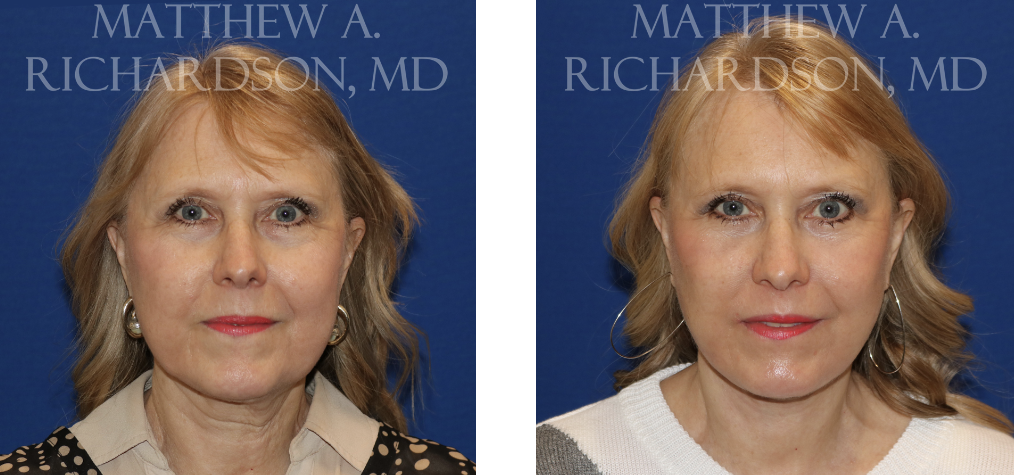Facelift
Conveniently Located to Serve the Dallas, Fort Worth, Collin, and Denton Counties.
Conveniently Located to Serve the Dallas, Fort Worth, Collin, and Denton Counties.
Conveniently Located to Serve the Dallas, Fort Worth, Collin, and Denton Counties.


What is a Facelift?
While many people think that a facelift is a procedure that involves TOTAL facial rejuvenation, this is not the case.
In medical terms, a facelift involves lifting the cheeks and neck into a more youthful position. This results in improvement in the cheeks, neck, temple areas, jawline, and jowls.
A facelift may also be called a cheek and neck lift, necklift, cheek lift, or other terms, but in general, involves lifting the cheek and neck. There are also many different facelift techniques and facelift variations.
Brow lifts, eyelid surgery, lip rejuvenation, skin rejuvenation, etc are very commonly performed in conjunction with a facelift but are not technically part of the facelift procedure.
A facelift is a method of addressing age-related facial changes. As we age, several changes in the facial structures and tissues cause us to appear older. The skin begins to lose some of its elasticity due to changes in the collagen fibers, and the underlying bony structure may recede. This allows the effects of gravity to pull the skin and tissues downward, causing deepening of the nasolabial folds, jowls, and loss of the angle between the chin and the neck.
A facelift, also known as a rhytidectomy, can reverse these age-related changes by repositioning the deeper tissues back to their original position, creating a more youthful appearance that can make a person appear a decade younger.
Due to the three-dimensional changes that occur with facial aging, facelifts are commonly performed in conjunction with procedures such as placement of fillers, implants, or transplant of the patient’s fat into areas of the face that have experienced volume loss over the years. Dr. Cain and Dr. Richardson are both highly skilled in the art and science of facial assessment and can recommend which procedures would most successfully address your concerns during your consultation.
Many patients are concerned that undergoing a facelift will cause the face to appear “pulled back” or wind-swept, or they worry that there will be unsightly scars that make it apparent they have undergone surgery. Dr. Richardson and Dr. Cain are both fellowship-trained in facial aesthetic surgery and use modern techniques to hide incision lines and provide natural, individualized results that leave the patient looking youthful and refreshed, without the unnatural appearance that some associate with cosmetic facial surgery.
How is a facelift performed? What happens during a facelift?
A facelift is performed by creating incisions (hidden around the ears), and lifting and tightening not just the skin, but the fascia and muscle layers under the skin. When facelifts were first being performed many years ago, surgeons just tightened the skin and trimmed away the excess skin. They then discovered that the results were not very good and did not last very long.
We now know that tightening the superficial muscular aponeurotic system (SMAS) under the skin provides excellent long-term results, and should be performed as part of every facelift procedure, even a mini-lift or any other “brand name” type of facelift. With this technique, the skin is lifted off the underlying tissue, the SMAS is tightened first, and then the skin is trimmed and tightened.
In some cases, the muscle bands in the neck may be cut and/or sewn together under the chin. This is known as a platysmaplasty and is commonly performed as part of a facelift procedure in select patients. Not all patients need a platysmaplasty. In almost every facelift procedure, some degree of liposuction is performed in the neck, but again, not every patient may need this.
Is a facelift painful?
Facelift procedures are generally not very painful at all. During the surgery, anesthesia is administered by our board-certified anesthesiologists in either the form of IV sedation (most commonly) or general anesthesia (rarely). In all cases, patients are asleep and do not experience any pain or discomfort during the procedure.
We supplement any systemic anesthesia with local anesthesia, which keeps patients comfortable both during and after the procedure. Most patients take very little if any pain medication after surgery. Patients almost always describe a sensation of the cheeks and neck feeling “tight” or numb, but rarely complain of much pain at all.
What Can I Expect After a Facelift?
Patients should expect some degree of bruising and swelling. While this varies from one patient to the next, we tell most patients to plan for 1-2 weeks of downtime from social activities. Most patients are back to all normal activities within two weeks.
In our practice, almost all sutures are removed one week after surgery, but we ask patients to avoid strenuous activity like heavy lifting, exercise, etc. for at least two weeks post-operatively. Patients can expect some numbness around the ears that can last several weeks to a few months as well.
Some mild swelling can last beyond the two-week mark, but this is usually only noticeable to the patient and our team, not to people in public or even friends and family. Patients who have had a previous facelift tend to heal even faster with less downtime.
How is a facelift different from a necklift, a “thread lift,” or any other lifting technique?
A facelift is a long-lasting surgical procedure with proven results. Many fad techniques or name brand lifting techniques are simply a matter of semantics or a marketing technique designed to trick the patient into thinking that a facelift is something else. A necklift is generally a part of a facelift procedure as described above.

What are the contraindications to a facelift?
Patients with serious medical conditions may not be candidates for an elective cosmetic procedure like a facelift. We do not want to put a patient’s health at risk for an elective procedure. That being said, minor health issues like well-controlled diabetes, high blood pressure, etc. are usually not a problem.
We will often require that you have a history and physical exam by your primary care provider to ensure that you are healthy enough to undergo a facelift procedure under anesthesia. Wound healing problems like collagen disorders, vascular disease, and autoimmune diseases might preclude you from having surgery. Pregnancy, bleeding disorders, kidney failure, and a high risk of heart attack or stroke are contraindications as well.
Is a facelift safe for all skin types, ethnicities, and races?
Yes, facelifts can be performed on patients of all skin types, colors, races, etc.
When should I get a facelift?
There is no “right” age to get a facelift. Most patients are in their 40s to 60s, but patients even as young as their 30s may be candidate for a mini-lift, and we have performed facelifts on patients even into their 90s. The most important factor is the patient’s anatomy and their desired goals for treatment.
Are facelifts only for women?
Absolutely not! While not frequently talked about, we commonly perform facelift procedures in men. Another similar procedure that is an option for a man is a direct neck lift procedure. Read more on our necklift page for more details.

*Individual Results may vary.
Real Patient Photo Gallery
View before-and-after pictures of real patients
Who is qualified to perform a facelift?
A facelift should be performed by a board-certified surgeon who is a fellowship-trained facial plastic surgeon or general plastic surgeon. Many non-surgeons perform all sorts of “non-invasive” thread lifting techniques and even some surgical facelift procedures. In our opinion, these procedures are unsafe in these situations and are very likely to lead to unhappy patients who then come to us for solutions.
Please look for surgeons who are fellowship-trained in the United States or Canada in plastic surgery or facial plastic surgery, not dermatology, “cosmetic surgery”, oral-maxillofacial surgery, ophthalmology, oculoplastic surgery, family medicine, or any other specialty.
Is a facelift safe?
Yes, in general, facelifts have very low complication rates. Like any procedure or medication, there are some risks involved. Common risks include bruising, swelling, numbness, and mild discomfort. Scars are part of any surgical procedure but are usually minimal and extremely well-hidden.
Bleeding is the biggest risk after a facelift, and this risk is minimized by patients following our post-operative instructions very closely. There are risks of permanent nerve injury, infection, and wound healing problems, but these are extremely rare and we do many things to minimize these risks before, during, and after surgery.
How Long Does a Facelift Last? Is It Permanent?
In some ways, a facelift is permanent, in that a patient will always be better off than if they had never had surgery. Yes, the aging process continues, so over time, patients will see some degree of return of cheek and neck laxity, but this process is very slow.
Some patients will desire another “tuck up” lift procedure at some point, but this is usually a less invasive procedure with quicker recovery and is rarely performed less than 10 – 15 years after a first facelift procedure.
Will I look different after a facelift?
Yes and no. Yes, patients should look younger after a facelift. We like to aim for a goal of helping patients look at least 10 years younger. Patients seek us out because they want to look like a younger version of themselves, not look like someone else.
When performed properly by an expert facial surgeon, a patient should not look “pulled”, “stretched”, or strange. Look at our before and after photos to see that our patients look very natural, simply well-rested, or rejuvenated.
How much does a facelift cost?
Because surgical procedures and terminology can vary widely from one patient, provider, and location to another, it is almost impossible to give accurate surgical quotes over the phone or email. Keep in mind that many different factors affect the cost of a procedure, including the surgeon’s fee, the surgical technique involved, the facility fee for the operating room/staff/supplies, and the anesthesia fees.
For most facelift procedures, patients can expect to pay somewhere between $17,000 – $22,000. If other procedures are performed simultaneously, such as a brow lift, eyelid surgery, etc., additional fees are involved. After a consultation with Dr. Richardson or Dr. Cain, we will provide you with a detailed and exact surgical quote for the procedures that are discussed.
How can I set up a consultation for a Facelift Consultation?
Call or text Texas Facial Aesthetics at 469-362-6975 to set up a consultation with either Dr. Matthew Richardson or Dr. Jordan Cain. You can also email us at info@txfaces.com for more information.

